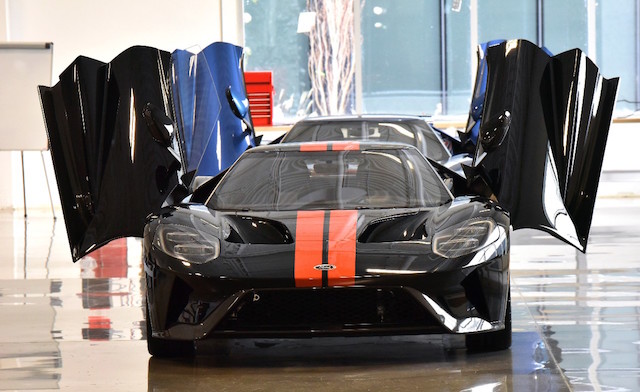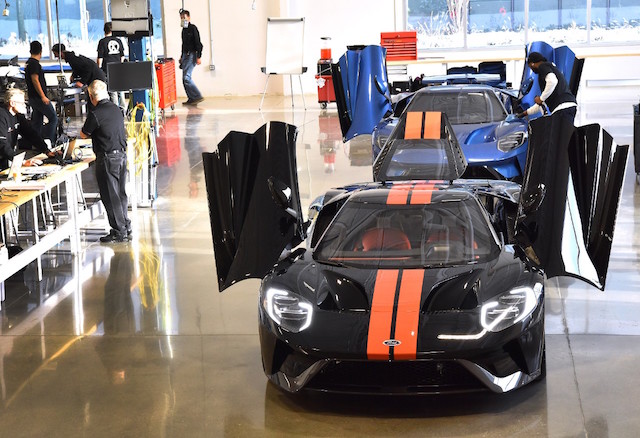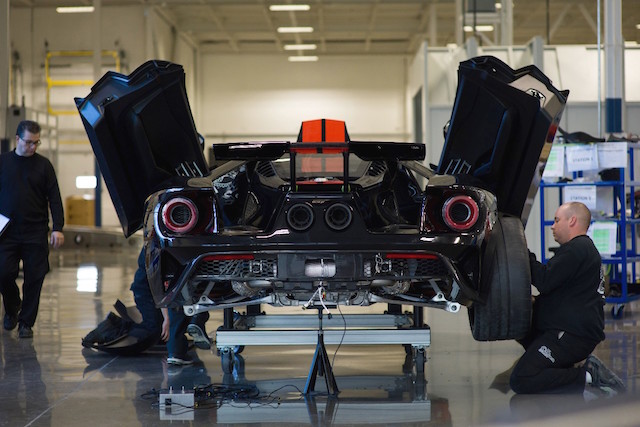
The first road-going version of the all-new 2017 Ford GT has rolled off the line, marking the beginning of a four-year extended production run.
Originally, the supercar Ford GT was going to be limited to 500 examples over two years, but demand has been such that Ford is expected to double production to 1000 units.
The decision to do so comes on the back of the commitment by Ford Performance to race the GT in both the International Motor Sport Association and World Endurance Championship series for four years.
Year three of production will cater for those who were already on the existing waiting list, while applications will open in early 2018 for year four’s allowance.
Said Dave Pericak, the global director for Ford Performance: “While we can’t build enough Ford GTs for everyone who has applied, we are going to produce additional vehicles in an effort to satisfy more of our most loyal Ford ambassadors.”
Ford received more than 6500 applications for the GT when the order book opened earlier this year. It quickly closed as Ford worked through applicants and bumped to the top of the list those with a Ford history. “We want to prioritise people who are going to care about the car, keep the car, and drive the car,” said the company.
The first year’s production will include an optional black and silver Le Mans heritage colour in honour of the paint job on the GT40 that Kiwis Bruce McLaren and Chris Amon drove to victory in the 1966 Le Mans.
In addition, the GT will be available in eight colours, as well as various themes that coordinate the interior and racing stripes. For example, owners can upgrade items such as the brake calipers, available in silver, blue, orange and red.
Ford design manager Barb Whalen said: “We walked a fine line with the colour and the materials in this vehicle – infusing energy through use of colour and balance while working to ensure the raw appeal of a performance car still shines through. Everything in the Ford GT was intentionally designed to express ultimate performance.”
The GT’s body is made mostly of carbon fibre and Ford promises the GT offers “one of the best power-to-weight ratios of any production car.” The brief from the very beginning was to make something different from the 2005 Ford GT, which used aluminium and magnesium components and a 410kW 5.4-litre supercharged V8.
 An early decision was made to build the 2016 GT from carbon fibre architecture, with a rear-mounted twin-turbocharged 3.5-litre Ecoboost V6 delivering more than 450kW to the rear wheels via a seven-speed dual-clutch gearbox.
An early decision was made to build the 2016 GT from carbon fibre architecture, with a rear-mounted twin-turbocharged 3.5-litre Ecoboost V6 delivering more than 450kW to the rear wheels via a seven-speed dual-clutch gearbox.
The new engine is a world away from an old-school V8. Its Electronic Control Unit processes 3000 signals from 50 sensors around the car and uses 28 microprocessors running 10 million lines of code – a Boeing 787 uses six million lines of code.
The GT’s interior and exterior was put together in Ford’s virtual design studio. Styling chief Elizabeth Baron and her team built from computer data a compete interior that engineers and designers could get into and sit down.
There they could explore the spacial relationships in the narrow cockpit by donning a special stereo viewing helmet and using software to look at elements in detail.
Interior design chief Amko Leenarts said: “In this car, there was no big centre console with a big shifter, because we had to be as lean and efficient as possible. We designed it so the steering column and pedals come to the driver.
“Because of the hyper-small space, we needed to carve out a lot of space from the dash to get a lightweight feel. When you get into the car, you get an immediate feel of raciness. All the functions are on the steering wheel.”
Ford says despite the dramatic styling of the GT, the low stance and profile is instantly recognisable to fans of its predecessors, like the GT40. There are 20-inch wheels clad in Michelin Pilot Super Sport Cup tyres; the suspension is a torsion bar and pushrod set-up that is height-adjustable; carbon-ceramic brakes are standard.






